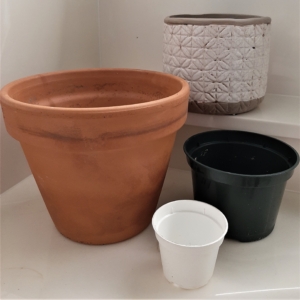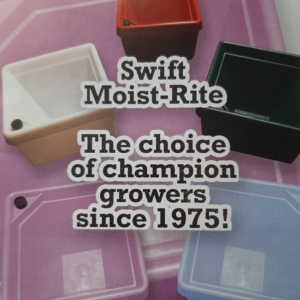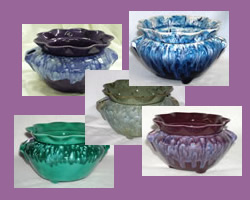An Analysis of Violet Pots
African Violet Magazine March/April 2019
Pots are small, but so essential to growing. This is a thorough analysis of basic information to help new and experienced growers sort out their potting needs and decisions. Learn the advantages of using each of the different types, including clay, plastic, ceramic and several types of self-watering pots.
Purpose of a pot is
- to mimic the natural root environment found in the native location in Africa;
- to make growing in homes efficient and convenient;
- to control environmental factors of water, disease, light, temperature, salts, etc.;
- to achieve the desired growth or habit.
Basic Considerations for Pots
- Opaque to minimize light on roots, which will discourage algae growth. Natural environment for roots is darkness.
- Clean and free of dirt, bacteria/fungus, and salt build-up.
- Safe edge for leaves which touch the rim. Edge may be rolled/blunted/broad, but should not damage petioles (leaf stems.) The edge should also protect leaves from salt build-up.
- Shape matters little, but if it is flared it will be easier to slip the plant out of the pot.
- Bottom of the pot may need either an indentation for increased air circulation, or a flat bottom for physical contact with capillary matting.
- Sized correctly so that diameter and depth match the size of the root growth of the plant.
- In African violets the roots of a fully mature standard plant will typically be about 1/3 the leaf span.
- Should allow for growth that is desired by grower and within the capability of the plant.
- Should restrict growth when space is limited or to stimulate flowering.
- Avoid an excessively large pot because it wastes potting mix, tends to encourage vegetative growth without flowering, and may lead to rotting.
- Stable so that it does not readily tip over in a breeze, with vibration or a bump, or around pets. Stability is especially important when growing tall, erect, top-heavy, or massive specimens.
- Have Good Drainage to allow excess water to escape and to allow removal of fertilizer salts from the root area by leaching. If no drainage exists, the grower will have to compensate in one of these ways:
- Potting media may have to be adapted such as adding a perlite layer or extra porous potting mix,
- Watchful watering,
- Frequent repotting.
Basic Pots 
- Plastic pots are excellent for use in moderate temperatures. They are inexpensive, available in many sizes (including recycled or repurposed containers) and easy to keep clean. They are also best for wick-watering or mat-watering, and the light weight makes it easier for vendors to ship. The primary problem is that they have a utilitarian appearance which may not be suitable in some locations.
- Ceramic pots are popular because of their upscale decorator appearance. They look and are more expensive. When a beautiful ceramic pot lacks drain holes, many growers opt to hide less attractive pots inside the pretty pot.
- Clay pots work well in excessive heat because evaporation from sides has cooling effect. Clay is good for growers with excessive watering habits, it is stable (won’t fall over), and it has a quaint decorator appearance. But clay has problems:
- Weight makes it expensive to ship and adds to the cost,
- Salts may build up on rim and sanitation may be difficult,
- Evaporation makes it unsuitable for wick-watering.
Specialty Pots
- Two-part ceramic self-watering (pots shown are sold by LJ Accents)
- Very decorative pots primarily available for standard size violets,
- Buy from reliable dealer as clays may vary in porosity,
- Inside pot has unglazed base which allows water to seep from reservoir,
- Recommend repotting into fresh potting mix once per year.
- Oyama planters (pots shown are sold by Glenda’s House of Violets)
- Plastic pot system designed to provide ideal soil moisture for violet roots,
- Sold in several sizes,
- Water reservoir is hidden when inner pot is in place,
- Follow package directions for good results,
- May be used in AVSA horticultural exhibits.
- Dandy pots
- Decorative colorful plastic pots designed to sit on top of a matching reservoir,
- Sold in several sizes at moderate prices,
- Wick-watering system,
- Requires potting mix with good porosity.
- Swift Moist-Rite Self-Watering Pots

- Moist-Rite works on a vacuum system.
- It has an inner and outer wall with the space between acting as a water chamber.
- There is a fill hole at the top of the planter that is closed off with a rubber stopper.
- Sold by the manufacturer who resides in Oklahoma. Several colors available.
Each grower will make different choices. Which pot fits your budget and is best for your needs?



